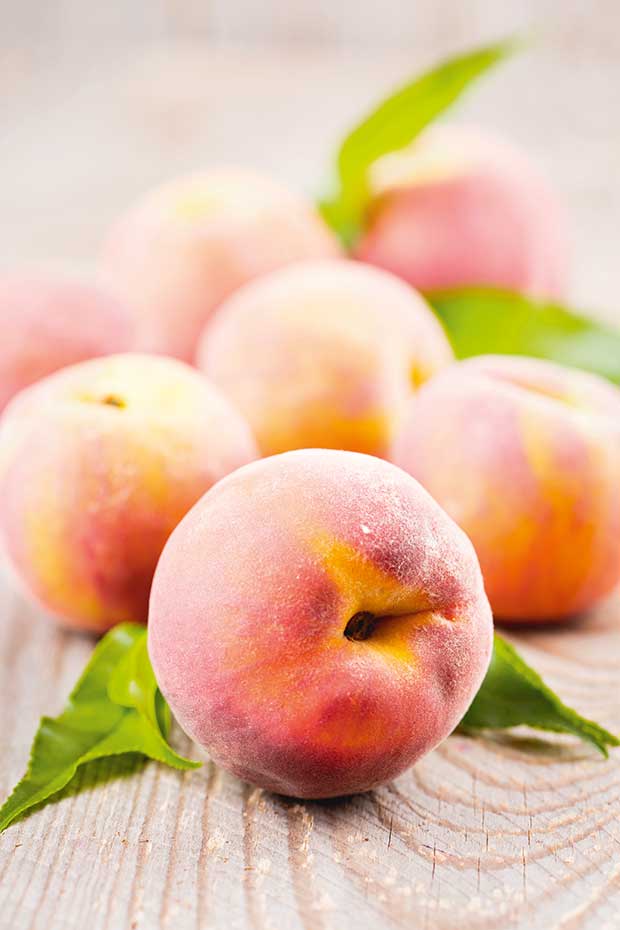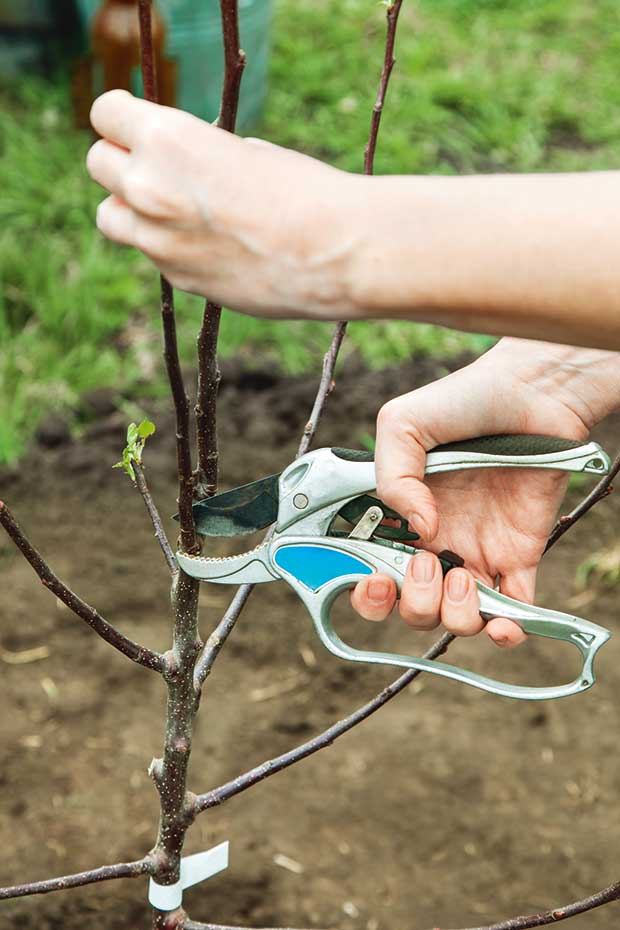How good peach tree pruning can make your tree more productive

Pruning a peach tree can be a test of a marriage but the results are bountiful.
Words: Jenny Somervell
We have battled for almost 10 years to get a peach harvest, thanks to our less-than-ideal climate here in North Canterbury.
But two shelves laden with preserved stone fruit remind me of last summer’s miracle.
“Are you still eating them?” husband Ken reminded me daily as he checked the bumper crop ripening on our trees. “I’ll need the jars for the next lot soon!”
I gave it my best shot. But we hauled bucket after bucket of peaches and nectarines off our trees for the second year in a row. There was a scurry to find enough jars.
Harvesting fruit last year was a timely reminder of why we need to prune. The high, upward-pointing, fruit-bearing leaders at the top of the tree – which we had unwisely failed to cut back – could only be picked by my tall husband on a ladder at a stretch. I stood at the bottom, shouting instructions.
UPWARD AND UPWARD
Peaches reach for the sun. An unpruned peach tree will quickly overgrow at the top, fruiting at the extremities of long, unreachable branches, and producing weak, sparse growth in the lower framework.
If you want to be able to pick fruit easily you need to keep the height down to encourage fruiting lower down. However, the trick is not too low. Low-hanging branches are a constant pain, obstructing the lawnmower and pathways around the garden.
Branch position is important too. On our trees, branches rubbed against each other, causing damage. Branches on top of each other shaded fruit, resulting in some with a greenish tinge that never ripened properly.
Fruit that was too close together on laterals either failed to size up, or was blemished where the skins touched. Overladen branches were stretched beyond their bearing capacity. One heavily-laden branch scraped so low, we had to wash dirt off the fruit before eating it.

Our peaches ended up in the vegetable garden when overladen branches got too heavy.
One of the reasons we didn’t cut our trees back far enough was that I screamed too much when Ken made bold cuts. This was a big mistake.
Over the years I have learned that it is hard to over-prune peaches and nectarines. They are the most forgiving of trees and I needed to be too. Even if you botch it up – which we have done – you can fix your mistake the following year.
In our first year of pruning, we set out with good intentions, armed with new secateurs and an array of pruning books.
Unfortunately, the instructions were conflicting, leading to neighbour-disturbing, time-consuming arguments as we debated every cut. It is a strong marriage that can survive pruning trees.
Eight years after that first argument we are still together, having sussed the basics. We’re also seeing the satisfying results of our combined labour.
Each year, before we start, we run over (and agree on!) the basic principles:
• peaches and nectarines fruit on current wood only, so replacement wood is needed each season;
• stonefruit are very sensitive to shading and need an open framework, allowing for lots of light and air movement;
• we aim for a low, spreading tree with fruiting laterals lower down.

We are both still fruit-focused, but these days we are more relaxed. And we also divide the labour. Ken focuses on developing the framework and keeping the height down and I try to leave him to it. I focus on pruning back old fruiting wood to encourage new fruiting laterals.
I’m also the hygiene squad, cleaning up the prunings and covering any large cuts with pruning paste to avoid disease.
WHEN IS THE RIGHT TIME TO PRUNE?
The general consensus seems to be to avoid pruning stone fruit in winter.
Definitely don’t do it in wet conditions, due to the greater risk of disease such as silver leaf, which enters through wounds. Most sources recommend pruning after fruiting in late summer-autumn, when the weather is warm and dry. However, we have also pruned in early spring.
New vigorous shoots heading towards the middle of the tree are best nipped out in summer as they arise, before they get too large.
THE HARDEST PART OF OWNING A PEACH TREE
I find thinning peaches difficult. I want them all. It also feels exceptionally risky when the dominant nor’west winds we get can easily blow most of a crop off the tree. We can lose the lot.
However, under favourable conditions, a peach tree will set far more fruit than it can carry to maturity. About four weeks after full bloom, thin the developing peaches, leaving them about 15cm apart on the branches.
The volume of fruit will be the same, but the size and quality will be much improved.

5 STEPS TO GOOD BASIC PRUNING
1. Remove any diseased, broken or low hanging branches.
2. Remove any vigorous upright shoots on the inside.
3. Cut back any excessive growth on the tree, especially at the top.
4. Prune to the desired height (about 3m) by shortening leaders to a lateral pointing in the desired outward direction. This means the tree will spread more but that’s ok. Don’t cut too close to a bud or more than 1cm from it.
5. Growth that has fruited should be cut back by a third to a half to produce new replacement laterals for the next season’s fruit. Removal of insufficient wood results in long, sparsely fruiting laterals. Have 20cm minimum between laterals.
HOW TO GET YOUR BEST PEACH TREE FROM DAY
For the first three years of a peach tree’s life, the focus needs to be on developing a strong framework of five to six strong leaders. We chose a ‘vase’ framework which allows plenty of light and air movement into the centre.
Forget about flowers and fruit for the first two years. Your patience will be rewarded.
On planting
Cut back to about 1m high, just above a lateral bud, to stimulate branch development and to compensate for root damage. We didn’t cut back hard enough in the first year and struggled to get strong leaders.
If there are no desirable branches, cut back all side branches to one bud. Then wait. In the first growing season rub off any shoots arising from the stem and pinch any tips not needed for limbs.
Year 2
Where possible, select leaders with wide-angle crotches (greater than 45° from vertical) and prune hard again to about half the length. The lowest can be as low as 30cm and the highest 75cm off the ground. Prune stronger leaders back harder to balance the tree. You can tie down branches to assist them to grow out and not up.
Almost all fruit is borne on laterals from the previous year’s wood. Retain some of these, removing any near the top of the leaders.
Year 3 and beyond
Once a framework is established, prune back to this each year, thinning and cutting back to outward-growing laterals to keep the tree and new wood low for easy picking.
HOW TO FIX AN UNLOVED TREE
If you have an older tree that has had little or no attention, you follow the same principles. Remove low-hanging, broken and diseased limbs and any upright, vigorous shoots crowding the centre.
Fruiting wood should be about the diameter of a pencil and from 30-45cm in length. Prune out poor quality fruiting wood which is anything less than pencil size. Anything that is over 60cm long can be cut back to about one third its length. Prune any vigorous upright limbs to an outside-pointing bud.
If, after a couple of years, the tree is not re-invigorated, it is probably best to take it out. Peach and nectarine trees are not as long-lived as other trees – 20 years productivity is doing very well – so start again, as you’ll need to be bringing on other trees as replacements anyway.
MORE HERE:
Recipe: Red-Fleshed Peach (Black Boy Peach) & Rhubarb Chutney
Love this story? Subscribe now!
 This article first appeared in NZ Lifestyle Block Magazine.
This article first appeared in NZ Lifestyle Block Magazine.
